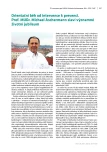IMProved Reduction of Outcomes: Vytorin Efficacy International Trial (studie IMPROVE-IT)
Authors:
Jindřich Špinar 1,2; Lenka Špinarová 3; Jiří Vítovec 3
Authors‘ workplace:
Interní kardiologická klinika LF MU a FN Brno, pracoviště Bohunice, přednosta prof. MUDr. Jindřich Špinar, CSc., FESC
1; Mezinárodní centrum klinického výzkumu – klinika kardiovaskulárních onemocnění FN u sv. Anny Brno, ředitel Gorazd B. Stonkin, M. D., MSc., Ph. D.
2; I. interní kardio-angiologická klinika LF MU a FN u sv. Anny Brno, přednostka prof. MUDr. Lenka Špinarová, CSc., FESC
3
Published in:
Vnitř Lék 2014; 60(12): 1095-1101
Category:
Review
Overview
Background:
The IMProved Reduction of Outcomes: Vytorin Efficacy International Trial (IMPROVE-IT) is evaluating the potential benefit for reduction in major cardiovascular (CV) events from the addition of ezetimibe versus placebo to 40 mg/d of simvastatin therapy in patients who present with acute coronary syndromes and have low-density lipoprotein cholesterol (LDL-C) ≤ 125 mg/dl.
Methods:
Randomized double blind clinical trial in patients with acute coronary syndrome and low cholesterol level. The simvastatin monotherapy arm’s LDL-C target was < 70 mg/dl, the comparison arm was simvastatin + ezetimibe. Ezetimibe was assumed to further lower LDL-C by 15 mg/dl and produce an estimated ~ 8 % to 9 % treatment effect. The primary composite end point was CV death, nonfatal myocardial infarction (MI), nonfatal stroke, rehospitalization for unstable angina (UA), and coronary revascularization (≥ 30 days postrandomization). The targeted number of events was 5,250.
Results:
18,144 patients were enroled with either ST segment elevation MI (STEMI, n = 5,192) or UA/non-ST segment elevation MI (UA/NSTEMI, n = 12,952) from October 2005 to July 2010. Primary endpoint occured in 2 742 patients (34.7 %) treated with simvastatin in monotherapy and in 2 572 patients (32.7 %) (p = 0.016) treated with combination. Compared to patients with coronary heart disease given the drug simvastatin plus a placebo, those given both simvastatin and the non-statin drug, ezetimibe, had a 6.4 % lower combined risk of subsequent heart attack, stroke, cardiovascular death, rehospitalization for unstable angina and procedures to restore blood flow to the heart. Heart attacks alone were reduced by 13 %, and non-fatal stroke by 20 %. Deaths from cardiovascular disease were statistically the same in both groups. Patients were followed an average of approximately six years, and some as long as 8.5 years. Approximately 2 patients out of every 100 patients treated for 7 years avoided a heart attack or stroke [Number Needed to Treat (NNT) = 50/7years].
Conclusions:
The study has shown a claer benefit from combination treatment with simvastatin and ezetimibe in patients with acute coronary syndrome and low LDL-C.
Key words:
acute coronary syndrome – combination therapy – ezetimibe – LDL-cholesterol
Sources
1. Naohisa Nakajima, Katsumi Miyauchi, Takayuki Yokoyama et al. Effect of combination of ezetimibe and a statin on coronary plaque regression in patients with acute coronary syndrome ZEUS trial (eZEtimibe Ultrasound Study). IJC Metabolic & Endocrine 2014; 3: 8–13.
2. Cannon CP, Giugliano RP, Blazing MA et al. Rationale and design of IMPROVE-IT (IMProved Reduction of Outcomes: Vytorin Efficacy International Trial): comparison of ezetimbe/simvastatin versus simvastatin monotherapy on cardiovascular outcomes in patients with acute coronary syndromes. Am Heart J 2008; 156(5): 826–832.
3. Califf RM, Lokhnygina Y, Cannon CP et al. An update on the IMProved reduction of outcomes: Vytorin Efficacy International Trial (IMPROVE-IT) design. Am Heart J 2010; 159(5): 705–709.
4. Laufs U, Descamps OS, Catapano AL et al. Understanding IMPROVE-IT and the cardinal role of LDL-C lowering in CVD prevention. European Heart Journal 2014; in press. Dostupné z DOI: <http://dx.doi.org/10.1093/eurheartj/ehu228>.
5. Blazing MA, Giugliano RP, Cannon CP et al. Evaluating cardiovascular event reduction with ezetimibe as an adjunct to simvastatin in 18,144 patients after acute coronary syndromes: final baseline characteristics of the IMPROVE-IT study population. Am Heart J 2014; 168(2): 205–212.
Labels
Diabetology Endocrinology Internal medicineArticle was published in
Internal Medicine

2014 Issue 12
Most read in this issue
- Percutaneous approach for treating mitral regurgitation with mitral clip (MitraClip)
-
Anaemia and iron deficiency in clinical practice:
from cardiology to gastroenterology and beyond - Obesity and heart
- Embolic ischemic strokes
